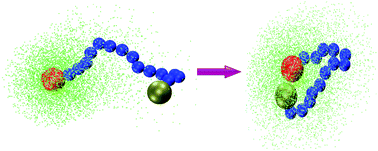Ring closure dynamics for a chemically active polymer
Abstract
The principles that underlie the motion of colloidal particles in concentration gradients and the propulsion of chemically-powered synthetic nanomotors are used to design active polymer chains. The active chains contain catalytic and noncatalytic monomers, or beads, at the ends or elsewhere along the polymer chain. A chemical reaction at the catalytic bead produces a self-generated concentration gradient and the noncatalytic bead responds to this gradient by a diffusiophoretic mechanism that causes these two beads to move towards each other. Because of this chemotactic response, the dynamical properties of these active polymer chains are very different from their inactive counterparts. In particular, we show that ring closure and loop formation are much more rapid than those for inactive chains, which rely primarily on diffusion to bring distant portions of the chain in close proximity. The mechanism presented in this paper can be extended to other chemical systems which rely on diffusion to bring reagents into contact for reactions to occur. This study suggests the possibility that synthetic systems could make use of chemically-powered active motion or chemotaxis to effectively carry out complex transport tasks in reaction dynamics, much like those that molecular motors perform in biological systems.


 Please wait while we load your content...
Please wait while we load your content...